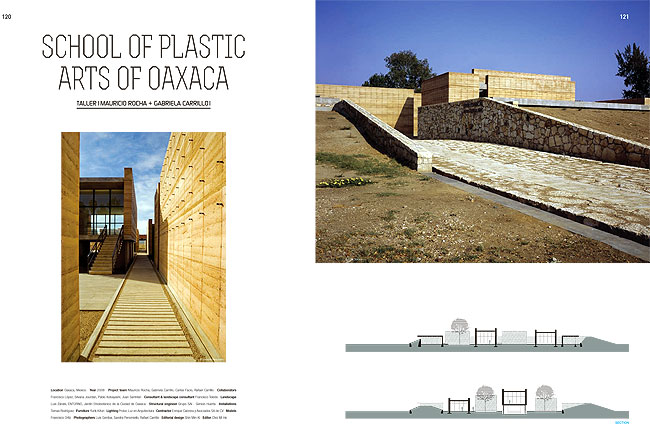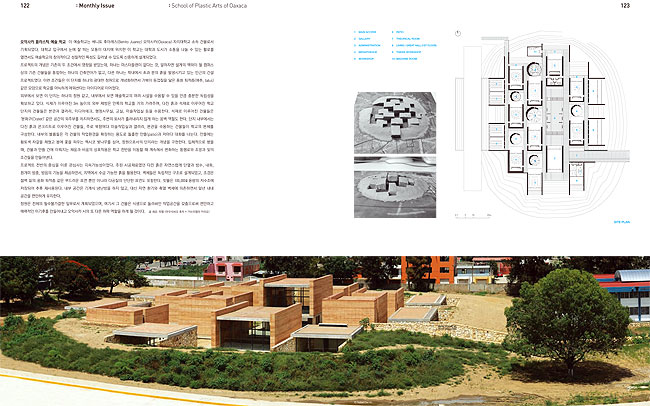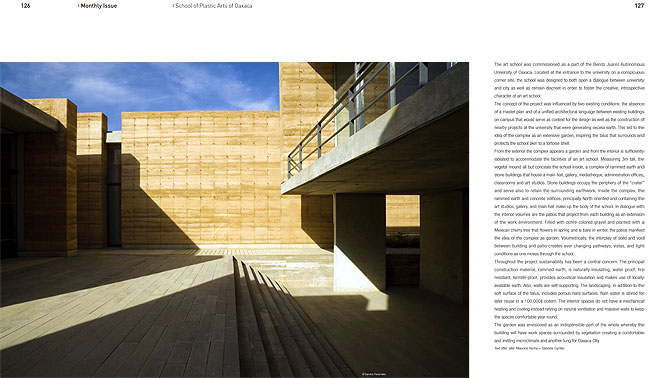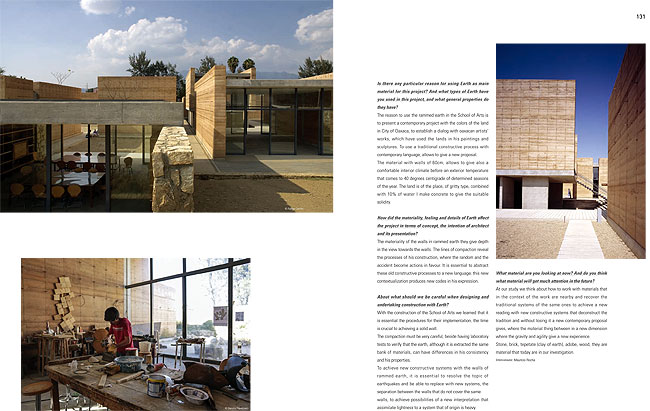GATEWAY to the McDowell Sonoran Preserve
WEDDLE GILMORE black rock studio




맥도웰 소노란 보호구역 출입구 <맥도웰 소노란 보호구역(McDowell Sonoran Preserve) 출입구>는 혁신적인 설계와 섬세한 시공, 그리고 서식지 보존과 지속가능성에 헌신하는 공동체가 어떻게 환경을 보존하면서도 오솔길의 주 출입구를 만들어낼 수 있는지를 보여준다.
도보?산악자전거?승마 여행자는 이 출입구에서 출발하여 맥도웰 소노란 보호구역 내에 얽히고설킨 45마일 이상의 오솔길을 이용할 수 있다. 이곳은 여행자들이 자신의 체력 조건이나 도보 여행 능력과는 상관없이, 사막의 신비를 탐험 혹은 경험하는 여정을 시작할 수 있는 곳이다. 동?식물 서식지는 수집과 보관, 더하여 천연 사막의 지면을 풍부한 유기물질과 토종 종자를 함유한 식물로 대체하는 복원이 이뤄졌고, 복원 프로그램에 참여한 자원봉사자들은 총 4,200시간이 넘는 시간을 투자하여 작업했다.
출입구가 위치한 대지는 진입도로와 주차장 및 건물들과 천연 배수로 패턴이 통합되도록 설계되었다. 대지 전반에 걸친 천연 소협곡들의 패턴을 유지함으로써, 필수적인 물매의 장애물을 최소화하고 오솔길 초입의 서식지에 개발이 미칠 영향도 최소화했다. 주차구역과 진입도로는 풍화된 화강석을 정착시키는 포장 방식으로 시공했는데, 이러한 포장도로는 천연 사막의 특성을 유지하면서도 유출수를 최소화한다. 건물들을 구성하는 다진 흙벽은 오로지 천연적인 흙 재료만 활용하는 만큼 구조물이 풍경과 자연스럽게 어울릴 수 있게 해준다. 출입구의 지붕은 천연 사막의 암석 잔돌로 덮었기 때문에, 산길에서 동쪽을 보면 지붕이 사막 속으로 스며드는 것처럼 보인다.
이 출입구는 수많은 자원 보존의 사례를 보여준다. 18kW 전력의 태양광발전 시스템이 생산하는 재생에너지는 오솔길 초입에서 ‘넷 제로(net zero)’ 에너지 소비를 달성할 수 있을 만큼의 태양열 전력을 만들어낸다. 설계의 또 다른 핵심 원리는 물 보존이다.
지붕에 떨어지는 빗물은 연간 대략 5만 갤런이 모여 빗물 수확이 이뤄지고, 이렇게 수확된 빗물은 지하 저수조에 보관되어 조경 관개에 필요한 물을 100% 공급하게 된다. 건설폐기물을 재활용하기 위해 노력한 결과, 폐기물 중 약 90%가 지역 재활용 프로그램에 다시 쓰이게 되었다. 게다가 이 건물은 20% 이상의 재료가 재활용 재료여서, 원자재를 발굴하여 건설 재료로 제작할 때 일어나는 환경적 영향을 최소화한다.
글 제공: 웨들 길모어 블랙 록 스튜디오
The [Gateway to the McDowell Sonoran Preserve] illustrates how innovative design, careful construction, and a community committed to habitat preservation and sustainability can create a major trailhead while respecting the environment. From the Gateway, hikers, mountain bikers, and equestrians can access a network of over 45 miles of trails within the McDowell Sonoran Preserve. The Gateway is the location individuals regardless of their physical condition or hiking capability can go to explore and experience the magic of the Sonoran Desert. Habitat restoration included collecting, storing and replacing the natural desert surface with plant litter that contains rich organic matter and native seeds.
In all, the salvage program included over 4,200 hours of volunteer service. The Gateway site is designed so that the entry drive, parking and buildings integrate with the natural drainage patterns of the site. Retaining the pattern of native arroyos throughout the site minimizes the necessary grading disturbances and allows for the Trailhead to be developed with minimal habitat impact. Parking areas and driveways are constructed with stabilized decomposed granite paving, which acts to retain the natural desert character and minimizing drainage run off. The rammed earth walls of the buildings utilize only native earth materials and allow the structures to blend seamlessly into the landscape.
The roof of the Gateway is covered in native desert rock cobble allowing it to disappear into the desert when viewed from the mountain trails to the east. The Gateway demonstrates numerous examples of resource conservation. Renewable energy produced by the 18kW solar system generate as much solar electricity as the Gateway consumes leading to a ‘net zero’ energy consumption for the Trailhead.
Water conservation is another key principle in the design. Optimum rainwater harvesting occurs by collecting approximately 50,000 gallons of rainwater annually that lands on the roof and is stored in an underground cistern, providing 100% of the water needed for landscape irrigation. Construction recycling efforts led to approximately 90% of the construction waste being redirected into local recycling programs. In addition the building contains more than 20% recycled materials, minimizing the impact to the environment caused by mining raw material resources and fabricating them into construction material.
Text offer: WEDDLE GILMORE black rock studio
건축문화 2016년 11월호 [Monthly Issue]페이지 © 에이엔씨출판(주)